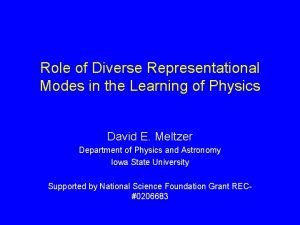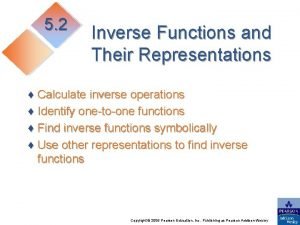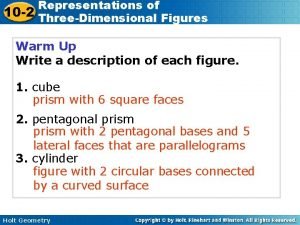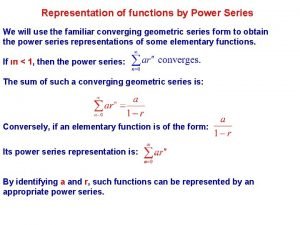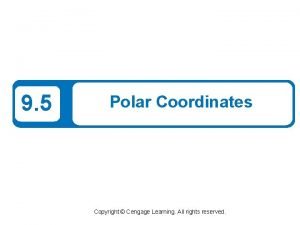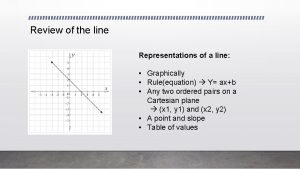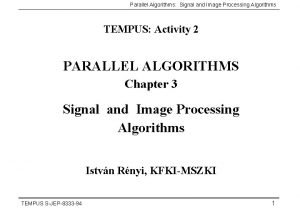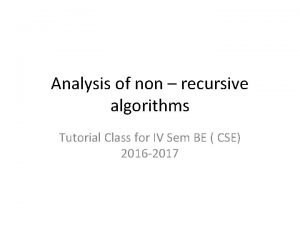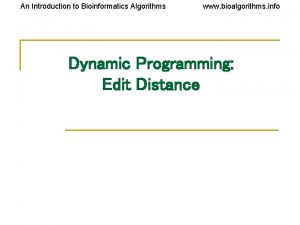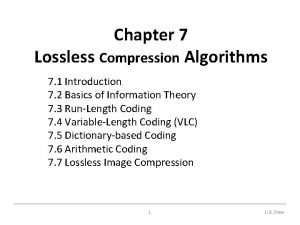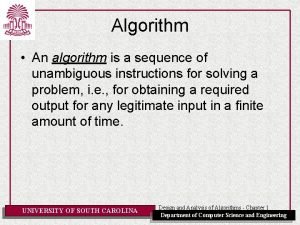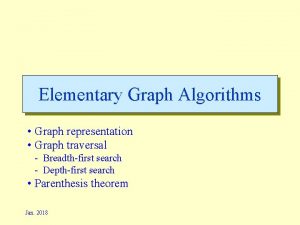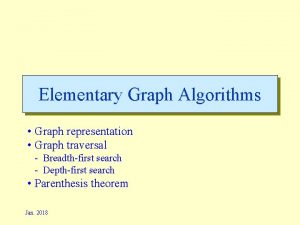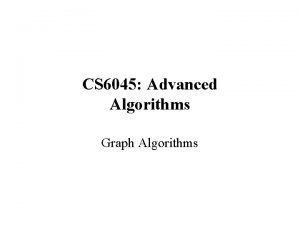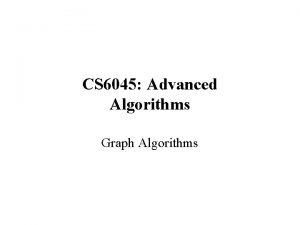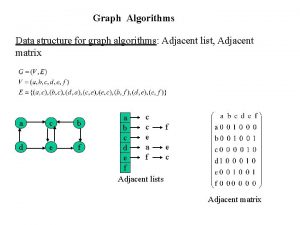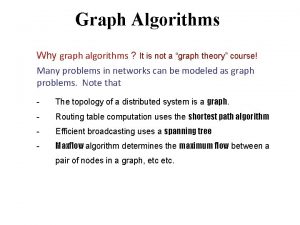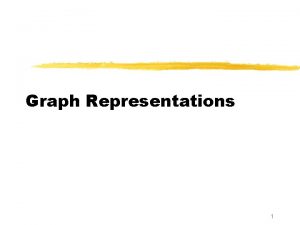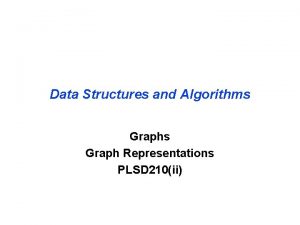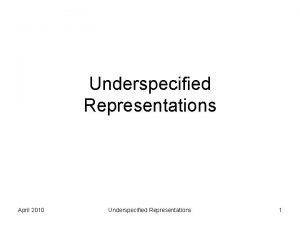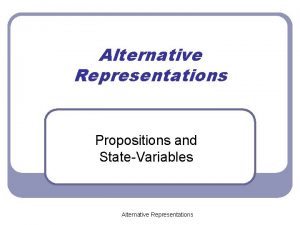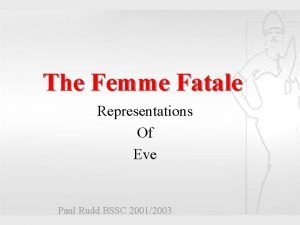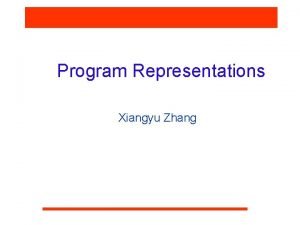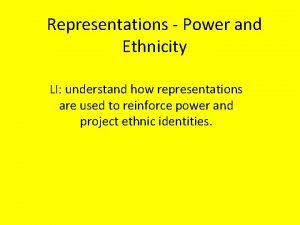Graph Algorithms n Representations of graphsundirected graph n












































- Slides: 44

Graph Algorithms

n Representations of graphs:undirected graph n An undirected graph G have five vertices and seven edges 1 edge 2 vertex 3 5 n n 4 An adjacency-list representation of G 1 2 5 / 2 1 5 3 2 4 4 2 5 3 / 5 4 1 1 / 3 / The adjacency-matrix representation of G 1 2 3 4 5 1 0 0 1 2 1 0 1 1 1 3 0 1 0 4 0 1 1 0 1 5 1 1 0 0 0 4 /

n Representations of graphs:directed graph n n n An directed graph G have six vertices and eight edges 1 2 3 4 5 6 An adjacency-list representation of G 1 2 2 5 3 6 4 2 / 5 4 / 6 6 / 4 / 5 / / The adjacency-matrix representation of G 1 1 0 2 1 3 0 4 1 5 0 6 0 2 0 0 1 0 3 0 0 1 1 4 0 1 0 0 5 0 0 0 1 0 0 6 0 0 0 1

BFS(G, s) 1. for each vertex u∈ G. V-{s} 2. u. color = WHITE 3. u. d = ∞ 4. u. π = NIL 5. s. color = GREEN 6. s. d = 0 7. s. π = NIL 8. Q = empty 9. Enqueue(Q, s) 10. while Q ≠ empty 11. u = Dequeue(Q) 12. for each v∈ G. Adj[u] 13. if v. color == WHITE 14. v. color = GREEN 15. v. d = u. d + 1 16. v. π = u 17. Enqueue(Q, v) 18. u. color = BLACK Time Complexity: O(|E|+|V|) Elementary Graph Algorithms 4

n The operation of BFS on an undirected graph (a) r s t u (b) 0 r s 1 0 t u x y 1 v x w Q (c) (e) Q s t 1 0 2 1 2 w x Q u (d) y s t 1 0 2 2 1 2 v w x Q t x 1 2 2 s t u 1 0 2 3 2 1 2 v w x x v u 2 2 3 y (f) w r 1 1 r r r Q w s 0 r v v y u y x v 1 2 2 t r s t u 1 0 2 3 2 1 2 3 v w x y Q v u y 2 3 3

(g) r s t u 1 0 2 3 1 2 w x 2 v 2 Q (i) r s t u 1 0 2 3 3 2 1 2 3 y v w x y u y 3 3 y 3 r s t u 1 0 2 3 2 1 2 3 v w x y Q (h)

n Breadth-first search: n n n Initially, vertices are colored white. Discovered vertices are colored green. When done, discovered vertices are colored black. u. d stores the distance from s to u. u. π is a predecessor to u on its shortest path. Q is a first-in first-out queue. p 7.

n Properties of Breadth-first search: n n After execution of BFS, all nodes reachable from the source s are colored black. After execution of BFS, v. d is the distance of a shortest path from the source s to v for vertices v reachable from s. After execution of BFS, if v is reachable from s, then one of the shortest paths to v passes through the edge( v. π, v) at the end. After execution of BFS, the edges( v. π, v ) for v reachable from s form a breadth-first tree. p 8.

n Lemma 22. 1: n n n G=(V, E):a directed or undirected graph. s:an arbitrary vertex : the shortest-path distance from s to v. Then for any Proof: u 1 s v p 9.

n Lemma 22. 2: n n n G=(V, E):a directed or undirected graph. s:an arbitrary vertex u. d: the distance from s to u computed by the algorithm Suppose that BFS is run on G from s. Then on termination, for each vertex v ∈ V, the value v. d computed by BFS satisfies v. d ≥ δ (s, v). Proof: By induction on the number Enqueue operations. Basis: when s is placed in Q. s. d =0 = δ(s, s) for all Induction Step: Consider a white vertex v discovered during the search from a vertex u. Inductive hypothesis implies u. d ≥ δ (s, u). By Lemma 22. 1, v. d = u. d +1 ≥ δ(s, u) + 1 ≥ δ(s, v) From then on, v. d will not be changed again.

n head Lemma 22. 3: n tail Q:<v 1, v 2, …, vr>~ the queue when BFS executes on a graph G=(V, E). Then and for i=1, 2, …, r-1. Proof: By induction on the number of queue operations. Basis: when Q has only s. Induction Step: 1>: after dequeue: v 2 becomes the new head in Q. by inductive hypothesis. 2>:after enqueue a new vertex v into the Q. Let vr+1 be v. neighbors Note that u’s adjacency list is being scanned and u is just removed. Thus, And The rest , for i=1, …, r-1, remain unaffected.

n Thm 22. 5: (Correctness of BFS) n n 1. During the execution of BFS on G=(V, E), BFS discovers every vertex v ∈ V that is reachable from s, and on termination v. d = δ(s, v) 2. For any vertex v ≠ s reachable from s, one of the shortest paths from s to v is the shortest path from s to v. π followed by the edge ( v. π, v). p 12.

Proof: If v unreachable from s, s. d (s, v)=. By BFS, v is never discovered. By contradiction, suppose some vertex has a d value not equal to its shortest distance. Let v be the vertex with minimum (s, v) that has an incorrect d value. Let u be v’s immediate predecessor on the shortest path from s to v. So (s, v) = (s, u) +1. Because (s, u) < (s, v), we have u. d= (s, u). (*) Thus v. d > (s, v) = (s, u) + 1= u. d + 1. Consider the time when BFS chooses to dequeue u from Q. At this time v is either white, gray or black. Case 1: (v is white) line 15 set v. d = u. d + 1 ---contradicting (*) Case 2: (v is black) v is already not in Q, thus v. d u. d --- contradicting (*) Case 3: (v is gray) v became gray while dequeuing some vertex w, which was removed earlier than u. Thus v. d= w. d +1 and w. d u. d and so v. d u. d + 1 – again a contradiction! Thus we conclude v. d = (s, v) for all v. All vertices reachable from s must be discovered. If v. π =u, then v. d = u. d +1. Thus, we can obtain a shortest path from s to v by taking a shortest path from s to v. π then traversing the edge (v. π, v).

n Breadth-first trees: For a graph G=(V, E) with source s, define the predecessor subgraph of G as G’=(V’, E’), where V’ = { v V: v. π ≠ NIL} {s} and E’ = {(v. π, v): v V’- {s}}. G’ is a BF tree if V’ consists of the vertices from s to v in G’ and, for all v in V’, there is a unique simple path from s to v, which is also a shortest path from s to v in G. Lemma 22. 6: When applied to a graph G=(V, E), procedure BFS construct π so that G’= (V’, E’) is a BF tree. Proof: Line 16 of BFS sets v. π =u iff (u, v) ∈ E and (s, v) < . Thus V’ consists of the vertices in V reachable from s. Since G’ forms a tree, it contains a unique path from s to each vertex in V’. By Thm 22. 5, inductively, we have that every such path is a shortest path.

Print path演算法 可在執行過BFS演算法的圖上印出s到v的最短路徑。 如無路徑也會印出沒有路徑的訊息。 Print-Path(G, s, v) 1. if v == s 2. print s 3. elseif v. π == NIL 4. print “no path from” s “to” v 5. else Print-Path(G, s, v. π) 6. print v n Elementary Graph Algorithms 15 p 15.

Depth-first search n n n Nodes are initially white Nodes become gray when first discovered Nodes become black when they are done v. d records when v is first discovered v. f records when v is done u. d< u. f p 16.

(a) Discovery time v u (b) w 1/ y x (c) z (d) v 1/ 2/ x y z u v w u v 1/ 2/ 3/ 4/ 3/ x y w u z w z p 17.

(e) u v 1/ 2/ (f) w u v 1/ 2/ B (g) w B 4/ 3/ x y z u v 1/ 2/ w B (h) 4/5 3/ x y z u v 1/ 2/7 w B 4/5 3/6 x y z p 18.

(i) u v w 1/ 2/7 (j) B F 3/6 x y z u v w 1/8 2/7 9/ B F v 1/8 2/7 4/5 3/6 x y (l) 3/6 x y z z u v w 1/8 2/7 9/ B F 4/5 w B F 4/5 (k) u C 4/5 3/6 x y z p 19.

(m) u v w 1/8 2/7 9/ B F C 3/6 10/ x y z u v w 1/8 2/7 9/ B F 4/5 (o) (n) 4/5 3/6 10/11 x y z 4/5 3/6 10/ x y z (o) C B C u v w 1/8 2/7 9/12 B F B C 4/5 3/6 10/11 x y z B p 20.

n (u, v) n n n Back edges: if u is connected to an ancestor v in a depthfirst tree. (eg self-loop) Forward edges: if u is connected to an descendant v in a depth-first tree. Cross edges: if u is not connected to an ancestor v in the same depth-first tree. OR if v is not connected to an ancestor u in the same depth-first tree. OR if u and v belong to different depth-first trees. p 21.

DFS演算法 DFS(G) 1. for each vertex u∈ G. V 2. do u. color = WHITE 3. u. π = NIL 4. time = 0 5. for each vertex u ∈ G. V 6. if u. color == WHITE 7. DFS-Visit(G, u) Elementary Graph Algorithms 22 p 22.

DFS-Visit演算法 DFS-Visit(G, u) 1. time = time+1 //u has just been discovered 2. u. d = time 3. u. color = GRAY 4. for each v ∈ G. Adj[u] //explore edge (u, v) 5. if v. color == WHITE 6. v. π = u 7. DFS-Visit(G, v) 8. u. color = BLACK //DFS-Visit(G, u) is done 9. time = time + 1 10. u. f = time Elementary Graph Algorithms 23 p 23.

n n n The running time of DFS is O(V+E) After execution of DFS, all nodes are colored black After execution of DFS, the edges( v. �� , v) form a collection of depth-first tree, called a depthfirst forest. p 24.

n Edge Classification n 1. Tree edges( u, v ): u was discovered first using ( u, v ) n 2. Back edges( u, v ): v is an ancestor of u in the DFS tree n 3. Forward edges( u, v ): v is a descendent of u, not a tree edge n 4. Cross edges( u, v ): Other edges n Example n In a depth-first search of an undirected graph, every edge is either a tree edge or a back edge p 25.

(a) y z s t 3/6 2/9 1/10 11/16 C B B 4/5 x C F 12/13 C 14/15 C u 7/8 w v (b) t s z y v u w x 1 (s 2 3 (z (y 4 (x 5 6 7 8 9 10 11 12 13 14 15 16 x) y) (w w) z) s) (t (v v) (u u) t) p 26.

(c) s C t B F z v B C u C y w C x p 27.

n Thm 22. 7: (Parenthesis theorem) In any DFS of a graph G=( V, E ), for any two vertices u and v, exactly one of the following 3 conditions holds: (1). The intervals [u. d, u. f] and [v. d, v. f] are disjoint, (2). The interval [u. d, u. f] is contained entirely within the interval [v. d, v. f], and u is a descendant of v in the depth-first tree, (3). or as above with v as a descendant of u p 28.

Pf: 1. If u. d < v. d case 1: v. d < u. f : v was discovered while u was still gray. v is a descendant of u, and all v’s outgoing edges are explored So v is finished before finishing u. Thus (3) holds case 2: u. f < v. d u. d < u. f < v. d < v. f (1) holds 2. If v. d < u. d: Similarly, by switching the roles of u and v p 29.

n n Cor 8: v is a proper descendant of vertex u in the depth-first forest for a graph G iff u. d < v. f < u. f Thm 9: (White-path theorem) In a DF forest of G=( V, E ), vertex v is a descendant of u iff at the time u. d that the search discovers u, v can be reached from u along a path consisting entirely of white vertices p 30.

n Pf: “ ” v: descendant of u u w u. d < w. d, by the above cor. v Thus w is white at time u. d “ ” Assume at time u. d, v is reachable from u along a path of white vertices, but v does not become a descendant of u in DF tree w u v Descendant of u w. f <= u. f v must be discovered after u is discovered, but before w is finished. Thus, u. d < v. d < w. f <= u. f Thm 7 implies [v. d, v. f] is contained entirely in [u. d, u. f] By Cor 8, v is a descendant of u. p 31.

n Thm 22. 10: In a DFS of an undirected graph G, every edge of G is either a tree edge or a back edge Pf: Let and suppose u. d < v. d. Then v must be discovered and finished before finishing u n n If (u, v) is explored first in the direction from u to v, then (u, v) becomes a tree edge If (u, v) is explored first in the direction from v to u, then (u, v) is a back edge, since u is still gray at the time (u, v) is first explored p 32.

n Topological sort n 定義: A topological sort of a dag G=(V, E) is a linear ordering of all its vertices. (dag: Directed acyclic graph) 如 edge(u, v), u appears before v in the ordering undershorts socks 11/16 17/18 watch 9/10 pants 12/15 shoes shirt 1/8 belt 6/7 socks undershorts tie jacket pants 13/14 2/5 3/4 shoes watch shirt belt tie jacket p 33.

n TOPOLOGICAL-SORT(G): (V+E) 1. Call DFS(G) to compute finishing times v. f for each vertex v (V+E) 2. As each vertex is finished, insert it onto the front of a linked list O(1) 3. Return the linked list of vertices undershorts socks 11/16 17/18 watch 9/10 pants 12/15 shoes shirt 1/8 belt 6/7 socks 17/18 13/14 tie jacket 2/5 3/4 undershorts pants shoes watch shirt belt tie jacket 11/16 12/15 13/14 9/10 1/8 6/7 2/5 3/4 p 34.

Lemma 22. 11 A directed graph G is acyclic iff DFS(G) yields no back edges. pf: Suppose there is a back edge (u, v), v is an ancestor of u. Thus there is a path from v to u and a cycle exists. Suppose G has a cycle c. We show DFS(G) yields a back edge. n Let v be the first vertex to be discovered in c, and (u, v) be the preceding edge in c. n At time v. d, there is a path of white vertices from v to u. n By the white-path thm. , u becomes a descendant of v in the DF forest (u, v) is a back edge. n p 35.

n n n Thm 22. 12 TOPOLOGICAL-SORT(G) produces a topological sort of G pf: Suppose DFS is run to determine finishing times for vertices. It suffices to show that for any pair of u, v , if there is an edge from u to v, then v. f< u. f. When (u, v) is explored by DFS(G), v cannot be gray. Therefore v must be either white or black. 1. If v is white, it becomes a descendant of u, so v. f < u. f 2. If v is black, then v. f < u. f p 36.

n Strongly connected components: n n n A strongly connected component of a directed graph G(V, E) is a maximal set of vertices U V s. t. for every pair u, v U, u and v are reachable from each other. Given G=(V, E), define GT=(V, ET), where ET={(u, v): (v, u) E} Given a G with adjacency-list representation, it takes O(V+E) to create GT. G and GT have the same strongly connected components. p 37.

a b c d 13/14 11/16 1/10 8/9 12/15 3/4 2/7 5/6 e f g h G: a b c d 13/14 11/16 1/10 8/9 cd abe h fg GT : 12/15 3/4 2/7 5/6 e f g h

n n Strongly. Connected. Components(G) 1. Call DFS(G) to compute finishing times u. f for each vertex u 2. Compute GT 3. Call DFS(GT), but in the main loop of DFS, consider the vertices in order of decreasing u. f 4. Output the vertices of each tree in the depth-first forest of step 3 as a separate strongly connected component Time: (V+E) p 39.

n Lemma 22. 13: Let C and C’ be distinct strongly connected components in directed graph G=(V, E), let u, v in C and u’, v’ in C’, and suppose there is a path from u to u’ in in G. Then there cannot also be a path from v’ to v in G. Def: Let U V, then we define d(U) = min { u. d } u U f (U) = max { u. f } u U p 40.

Lemma 22. 14 Let C and C’ be distinct strongly connected components in directed graph G=(V, E). Suppose that there is an edge (u, v) in E, where u in C and v in C’. Then f (C) > f ( C’). pf: (1) If d(C) < d(C’): let x be the 1 st discovered vertex in C. At time x. d all vertices in C and C’ are white. There is a path from x to all (white) vertices in C and to all vertices in C’: x~↝ u v ~↝ w. All vertices in C and C’ are descendants of x. Thus x. f = f (C) > f(C’). n (2) If d(C) > d(C’): let y be the 1 st discovered vertex in C’. At time y. d all vertices in C’ are white and there is a path from y to all vertices in C’. I. e. all vertices in C’ are descendants of y. So y. f = f(C’). There cannot be a path from C’ to C. Thus any w in C has w. f > y. f and so f(C) > f(C’). p 41.

Corollary 22. 15: Let C and C’ be distinct strongly connected components in directed graph G=(V, E). Suppose that there is an edge (u, v) in , where u in C and v in C’. Then f ( C ) < f ( C’ ). Pf: It is clear that (v, u) is in E. By the previous lemma we have f( C’ ) > f ( C ). p 42.

n n Thm 22. 16 Strongly-Connected-Component(G) correctly computes the strongly connected components of a directed graph. pf: By induction on the number (k) of depth-first trees found in the DFS of GT, where each tree forms a strongly connected component. Basis: trivial for k=0. Inductive step: assume each of the first k DFS trees produced in line 3 is a SCC. Consider the (k+1)-st tree produced. Let u be the root of this tree and let u be in SCC C. Thus u. f = f ( C ) > f ( C’ ) for any other SCC C’ yet to be visited. Note we visit in decreasing finishing time. p 43.

n n All other vertices in C are descendant of u in its DFS. By inductive hypothesis and the previous Corollary 15 any edges in GT that leave C must be to SCC’s already visited. Thus, no vertex in any SCC other than C will be a descendant of u during the DFS of GT. Thus, the vertices of the DFS tree in GT that is rooted at u form exactly one SCC. p 44.
 W graph
W graph Undirected graph algorithms
Undirected graph algorithms Dfs algorithm
Dfs algorithm When graphs are life
When graphs are life Multiple representations
Multiple representations Isa 580
Isa 580 Elevation map grade 12 maths lit
Elevation map grade 12 maths lit What is nonlinguistic representation
What is nonlinguistic representation Efficient estimation of word representation in vector space
Efficient estimation of word representation in vector space Cultural representations and signifying practices
Cultural representations and signifying practices Functions and their representations
Functions and their representations Representations of three dimensional figures
Representations of three dimensional figures Types of maps in mathematical literacy grade 12
Types of maps in mathematical literacy grade 12 Map work mathematical literacy pdf
Map work mathematical literacy pdf Place value representations
Place value representations Time sequence pattern organizer examples
Time sequence pattern organizer examples Connecting representations
Connecting representations Efficient estimation of word representations invector space
Efficient estimation of word representations invector space On single image scale-up using sparse-representations
On single image scale-up using sparse-representations Representations of functions as power series
Representations of functions as power series Maps plans and other representations of the physical world
Maps plans and other representations of the physical world Simplified representations of complex economic activities
Simplified representations of complex economic activities Unit 1: media representations mark scheme
Unit 1: media representations mark scheme Multiple representations
Multiple representations Distributed representations of words
Distributed representations of words Character table d infinity h
Character table d infinity h A day in pompeii vimeo
A day in pompeii vimeo Flowchart is a pictorial representation of
Flowchart is a pictorial representation of Multiple representations of polar coordinates
Multiple representations of polar coordinates Representations of a line
Representations of a line Signature file structure in information retrieval system
Signature file structure in information retrieval system Parallel image processing algorithms
Parallel image processing algorithms Recursive and non recursive algorithm
Recursive and non recursive algorithm Tyrant torrent
Tyrant torrent Algorithm efficiency
Algorithm efficiency Bioalgorithms
Bioalgorithms Lossless compression algorithms in multimedia
Lossless compression algorithms in multimedia Scheduling algorithms examples
Scheduling algorithms examples Cluster analysis: basic concepts and algorithms
Cluster analysis: basic concepts and algorithms Unambiguous instructions meaning
Unambiguous instructions meaning Analyze algorithm
Analyze algorithm Advanced search algorithms
Advanced search algorithms Huffman coding - greedy algorithm
Huffman coding - greedy algorithm Algorithm analysis examples
Algorithm analysis examples Symmetric algorithms
Symmetric algorithms




